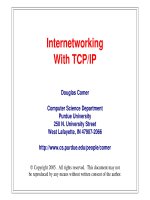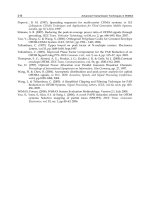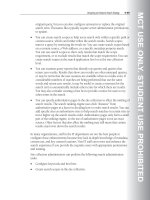Ebook Advanced myofascial techniques (Vol.1): Part 1
Bạn đang xem bản rút gọn của tài liệu. Xem và tải ngay bản đầy đủ của tài liệu tại đây (11.48 MB, 233 trang )
Volume1
AdvancedMyofascial
Techniques
Shoulder,Pelvis,FootandLeg
HANDSPRINGPUBLISHINGLIMITED
TheOldManse,Fountainhall,Pencaitland,EastLothianEH345EY,ScotlandTel:+441875341859
Website:www.handspringpublishing.com
Firstpublished2015intheUnitedKingdombyHandspringPublishingCopyright©TilLuchau2015
Copyright in illustrations as indicated at the end of each chapter All rights reserved. No parts of this
publication may be reproduced or transmitted in any form or by any means, electronic or mechanical,
includingphotocopying,recording,oranyinformationstorageandretrievalsystem,withouteithertheprior
writtenpermissionofthepublisheroralicensepermittingrestrictedcopyingintheUnitedKingdomissued
bytheCopyrightLicensingAgencyLtd,SaffronHouse,6–10KirbyStreet,LondonEC1N8TS.
ISBN978-1-909-16-2
eISBN978-1-909141-45-2
British Library Cataloguing in Publication Data A catalogue record for this book is available from
the British Library Library of Congress Cataloguing in Publication Data A catalog record for this
bookisavailablefromtheLibraryofCongressNoticeNeitherthePublishernortheAuthorassumes
any responsibility for any loss or injury and/or damage to persons or property arising out of or
relating to any use of the material contained in this book. It is the responsibility of the treating
practitioner, relying on independent expertise and knowledge of the patient, to determine the best
treatmentandmethodofapplicationforthepatient.
CommissioningEditorSarenaWolfaard
DesigndirectionandCoverdesignbyBruceHogarth,KinesisCreativeArtworkbyPrimalPicturesunless
otherwiseindicatedIndexbyAptara
TypesetbyDSMSoft
PrintedinCzechRepublicbyFinidrLtd.
The
Publisher’spolicyistousepapermanufacturedfromsustainableforests
Contents
Foreword
Preface
Acknowledgements
Reviewers
OnlineResources
Part1Essentials
1Bone
2Fascia,Part1:UnderstandingFascialChange
3Fascia,Part2:FascialToolsandTechniques
Part2LowerLimb
4Type1AnkleRestrictionsandPlantarFasciitis
5Type2RestrictionsandtheAnkleMortise
6AnkleInjuriesandtheFibula
7Hammertoes
8TheShoe-BoundArch
9HamstringInjuries
Part3PelvicGirdle
10HipMobility
11SciaticPain
12TheSacrotuberousLigament
13TheSacroiliacJoints
14TheIlia
Part4UpperLimb
15TheWristandCarpalBones
16TheThenarEminence
17FrozenShoulder,Part1:TheGlenohumeralJoint
18FrozenShoulder,Part2:TheRotatorCuff
Index
Foreword
Therehavebeennumerousbookswrittenaboutmyofascialapproachestohandsonmanualtherapy.Likethisbook,manyofthosecomefromthelonglineageof
fascial methodologies that include Ida Rolf’s structural integration and its
osteopathicinfluences,datingbacktoAndrewT.Still’swritingsonfasciafrom
the late 1800s. And as this book does, many other books leverage our more
recentlearningaboutfasciatorefineandenrichthislongtradition.
However, the focus on a select set of common client complaints, and the
provisionofpracticaltoolsandsuggestionsforworkingpractitionerstoputinto
practice immediately, makes Til Luchau’s book unique. Experienced
practitionerswillfindthought-provokingconceptsanddetails,withcitationsto
relevant research, to help them take their knowledge and creativity to an even
higherlevel.Atthesametime,newerpractitionerswillappreciatetheclarityand
accessibility of the verbal and visual instructions, as well as the step-by-step
progressionofthetechniques.
However,clarityandsimplicityshouldnotbeconfusedforalackofsubstanceor
sophistication.Duringthemorethan20yearsthatIhaveknownTilLuchauasa
colleague at the Rolf Institute of Structural Integration, I have learned an
incredibleamountfromhimwhileco-teachingnumerousclassesandexchanging
information. His unique ability to offer valuable tools to both experienced and
newerpractitionersdatesbacktoTilLuchau’searlyworkattheRolfInstitutein
Boulder, Colorado, USA. In the early 1990s, when Til Luchau was the
Coordinator of that institute’s Foundations of Rolfing Structural Integration
program,hewaschargedwithdevelopingacurriculumtoteachthefundamental
manual therapy skills needed for structural integration. The resulting ‘Skillful
Touch’syllabusisstillused(andbeingfurtherdeveloped)bytheRolfInstitute’s
USAfacultytoday.Afewyearslater,theRolfInstituteadministrationaskedhim
to offer continuing education seminars for professionals in allied fields,
introducingthemtostructuralintegrationideastogivethemimmediatetoolsto
use, and inspire their further learning. His ‘Advanced Myofascial Techniques’
workshopserieswasimmediatelypopularwithbodyworkers,physicaltherapists,
massage therapists, structural integration practitioners, chiropractors, and other
hands-on specialists, and although official affiliation with the Rolf Institute
ended amicably in 2010, today (in mid 2014) the Advanced Myofascial
Techniquesseminarserieshasseveralthousandalumniworldwide.
Thisbookisthereforelongoverdue,andwithoutadoubtwillbewelcomedby
the many practitioners who have been exposed to Til Luchau’s distinctive
teaching, writing, videos, and broadcasts. It will be obvious to the reader that
manyyearsofevolutionaryrefinementunderlietheideasandinstructionsinthis
text.
ThisisnotaRolfingorevenastructuralintegrationtextperse;notonlyisthe
Rolfingnametrademarked,butRolfingismuchmorethanasetoftechniques,
and is less focused on client complaints than on the overall relationship of the
body with gravity. Furthermore, there are many other influences in this book’s
material besides structural integration, including craniosacral therapy,
osteopathic principles, orthopedic approaches, and the eclectic bodywork
influencesofTil’stimepracticingattheEsalenInstituteinthe1980’s.
Thereismoretoanyapproachthanitstechniques.Aquietbutpervasivepointof
viewliesbehindthisbook’sanatomicallanguage,compellinggraphics,research
citations,anddetailedpracticalinstruction.Ifyoulookclosely,you’llseethatTil
Luchau’s background in somatic and group psychology (having worked for
manyyearsasasomaticpsychotherapistandgroupleader)comesthroughina
quiet, almost invisible way. This almost-hidden perspective emphasizes the
human,interactiveelementsofhands-onwork,andwillfindresonancewiththe
many practitioners who feel that working with their clients or patients yields
moresatisfyingresultsthanworkingonthem.
Thisattentiontotheinteractionbetweenpractitionerandclient,incombination
withattentiontothetechnicalandphysicalsidesofmanualtherapy,hasparallels
inourchangingviewoftheconnectivetissuesystemitself.Wearelearning,for
instance,thatitisn’tjustfascia’sinterestingmechanicalpropertiesthataccount
for its remarkable plasticity. It is becoming clear that fascia’s innervation and
resultingsensitivityalsoplaysaveryimportantrole.Thebeneficialeffectsthat
manual therapists see may owe as much to this fascial sensitivity as to the
fascia’spurelyphysicalproperties(ifnotevenmore).
OfcoursethestunningimagesfromPrimalPictures(andothers)arealargepart
ofthisbook’smessage.Whileweadmiretheseimages’intelligibilityandbeauty,
let’s remember that in the real body, myofascia is not neatly separated into
discrete structures; it is fascia’s often messy and complex interconnectedness
thatbestcharacterizesit.
Nobook,nomatterhowlavishlyillustratedorcarefullyworded,cansubstitute
forthelearningthathappensinanin-personcontext.Manyinthislineofwork
learnthroughexperiencing,feeling,anddoing.Toooften,booksleadbythinking
alone. This book’s usefulness in a wide range of clinical and educational
settings, and enduring value to practitioners, is that it includes all these
dimensions.
Dr.biol.hum.RobertSchleip
Director,FasciaResearchGroup
DivisionofNeurophysiology
UlmUniversity,Germany
Preface
Theabilitytoeaseanother’spainismeaningfulinawaythatfewotherthings
are.Paincriesforrelief—biologicallyitfunctionstomotivatethesufferertostop
something hurtful, or to seek respite. When someone in pain comes to us for
help,wearemuchmorethanjustpractitionersofatherapeuticmodality;weare,
in that moment, fellow human beings, together with another person facing a
pressing biologicalproblem.Whenwecanreducethepainofthosewhocome
seeking our help, we are fulfilling a need that lies at the core of our species’
biological and social functioning. Few things provide as much meaning and
purpose.
Ofcourse,ourworkisnotjustaboutrelievingpain.Noteveryonecomestous
becauseofpain.Sometimes,wearemosteffectivewhenweraiseourclients’or
patients’leveloffunctioningtoextenditbeyondthesimpleabsenceofpainor
dysfunction. And even when it seems like we can’t ease the physical pain of
those who have come to us for relief, our work can still be useful in many
profound ways; in fact, it is in these moments that both our mastery and our
humannessaremostneeded.
Still, when we can help relieve pain, we should. The techniques described in
these books represent some of the most effective ways that I have found for
doing this. They do not represent the whole story by any means—there are
many,manyotherwaysofaccomplishingsimilargoals,andtherearenumerous
techniques that did not make it into the text, simply because they did not lend
themselvestowrittendescription.
The techniques described here are taken from the body of work taught in
Advanced-Trainings.com’s Advanced Myofascial Techniques’ series of
workshopsandvideocourses.Initsprincipalandspecialtycourses,thisseminar
series presents a comprehensive system for working with the entire body,
currently encompassing over 40 session sequences and more than 350
techniques, tests, and procedures. The techniques chosen for this volume
(focusingonconditionsoftheappendages),aswellasthoseselectedforthenext
one (which will include techniques for spine, rib, head, and neck complaints)
represent a set of effective and accessible tools for some of the most common
client complaints. While they can be used as stand-alone techniques, I
recommend learning more about this approach through the other available
trainingformatsandmedia(manyofwhicharefreeandonline).
Goalsofthework
Paradoxically,eventhoughthetechniquesdescribedhereareoftenveryeffective
in addressing pain, relief from pain is only a secondary benefit of this way of
working. Our two primary goals are: 1. Increase options for movement; 2.
Refinetheproprioceptivesense.
The first goal (increase options for movement) includes all magnitudes of
movementandmobility,rangingfromsubtlemicromovementpulsationstogross
rangeofmovement.Thismeansthatweemploytheentirespectrumofdepthand
pressure with our touch. Often, our techniques use direct pressure to affect a
gross movement change. Sometimes, larger mobility isn’t possible until the
smaller, subtler intrinsic motions (such as movements of craniosacral therapy,
visceralmanipulation,andsoon)arealsoaddressed.Accordingly,youwillsee
bothdeep,directtouch,andsubtlereceptivetouchusedinthetechniqueshere.
Thesecondgoal(refineproprioception)impliesthatwewantourclientstofeel
theirbodiesinnewandenhancedwaysasaresultofourwork.‘Proprioception’
includes the sensations of one’s own body position and movement, and our
touch, pressure, and the movements we ask for can all evoke proprioceptive
learning. Recent research into the mechanisms of myofascial change suggests
thatthereisamuchlargerroleforproprioceptionthanhasbeenassumedinthe
past (discussed further in Chapter 2 , Understanding Fascial Change ). When
this body sense is awakened, it lays the groundwork for finer, more efficient
movementcoordination.Italsopavesthewayformanyotherbenefits,suchas
thedevelopmentofmoresustainablein-the-momentposturalchoices.
Secondarytothesemaingoals,thesetechniquesbringaboutotherbenefits.Pain,
athleticperformance,well-being,etc,alltendtoimprovewhenourtwoprimary
goals are addressed. However, less pain, improved performance, and any other
benefitsaretheendresults;themeanstothoseendsaresimplytoincreaseour
clients’optionsformovement,andinvitemorerefinedproprioception.
Ofcourse,othergoalscanbeservedbythetechniquesandtoolsdescribedhere.
A structural integration practitioner might see applications for improving
alignmentandintegration.Similarly,physicaltherapists,acupuncturists,massage
therapists,rehabilitationspecialists,andotherswillseewaystousethesetoolsto
serve their modalities’ therapeutic goals. But using these two primary goals
(more movement options and refined proprioception) as touchstones will help
simplify,clarify,andfocuseachtechnique’spurposeandapplication.
Thisbook’sassumptions
This book is intended for trained manual therapy practitioners in professional
practice (such as structural integration practitioners, physical and physiotherapists, physical therapy assistants, bodyworkers, massage therapists,
osteopaths,chiropractors,acupuncturists,andotherhands-onpractitioners).Itis
also appropriate for use by intermediate and advanced students of these
disciplines who are using this text within a training context. Accordingly, this
book assumes that the reader has familiarity with considerations and
contraindications for deep hands-on work. Where particularly important, or
where not obvious, these considerations are described in the text, but a basic
leveloftrainingandknowledgeisassumed.
Thesetechniquesareintendedastoolstobeusedwithinthelargercontextofa
session or series. Elements of this larger context might include interviewing,
assessment, preparation, strategizing and sequencing, balancing, closing, and
integration back into daily life. Each modality has its own ways of
accomplishingthesefunctions,and(althoughsomediscussionofsequencingis
plannedforvolumetwo),Iwillassumethatthereaderhasthistrainingaswell.
Books like this can serve to stimulate your imagination, innovation, and
versatility.However,Iassumethatthereaderwillrealizethatyoureallycannot
learnallyouneedtoknowaboutthesetechniquesfromabook.Tosomeextent,
video can help to round out the picture, and this book includes video links to
manyofthetechniquesdescribed(withvideoofalltechniquesbeingavailablein
thecompanionvideosets).However,themostimportantaspects,whichhaveto
do with the kinesthetic and experiential realities of actual touch and sensation,
can only be acquired through in-person mentoring and feedback, as well as by
actuallyreceivingandexperiencingtheworkbeingdescribed.
Of course, this book is just a starting point. As valuable as the methods and
pointsdescribedinthistextare,therecomesapointwherebettertechniquesand
tricks just aren’t the answer. Relieving pain can be relatively simple; however,
whenpaindoesnotgoaway,ourmasteryanddeeperhumannessiscalledforth.
It is then that we are faced with Austrian-born philosopher Marten Buber’s
dichotomy: we can either see others as objects (as “clients,” “patients,” or
problems to be fixed), or as actual people—unique, multidimensional, sentient
beings,justlikeourselves.
TilLuchau
BoulderColorado,2014
Acknowledgements
Almost everyone knows that writing a book takes work. What isn’t obvious is
thatabooktakesmanypeople’swork.
Aspecialthankstomycolleague,friendandmentorDr.RobertSchleipforhis
encouragement, and for his inspiring example of continuing fascination,
learning,facilitativeleadershipwithinourfield,andbeyond.Likeanorchestral
conductor,hebringsoutthebestinthosearoundhim,andweallbenefitfromhis
talents.
Thanks to Leslie Young PhD, Editor-in-Chief at Massage & Bodywork
Magazine, for featuring the ongoing Myofascial Techniques column, where
many of these ideas firstappeared.Herskilledteam,includingDarrenBuford,
Amy Klein, and others helped shape the first drafts of this material. Anne
Williams and Brian Halterman at the Associated Bodywork & Massage
Professionals (ABMP) played an important role by sponsoring and hosting the
MyofascialTechniqueswebinarseries.
I am grateful to Sarena Wolfaard, Andrew Stevenson, Bruce Hogarth at
Handspring Publishing Limited, for their patience, persistence, flexibility, and
collaborative spirit. Their dedication to quality, and passion for this field, has
beenajoytoworkwith.
My esteemed faculty colleagues at Advanced-Trainings.com have continually
contributed ideas, critique, dialog, techniques, and inspiration. They include
Larry Koliha, George Sullivan, Chris Pohowsky, Ellyn Vandenberg, Bethany
Ward, as well as many dedicated and skilled teaching assistants and students
around the world that are too numerous to list, but just as deserving of
acknowledgement.
Advanced-Trainings.cominstructorBethanyWardreadeverywordIwrote,and
made expert suggestions and corrections, often up against tight deadlines.
Patrick Dorsey contributed countless hours towards the book’s study guide
questions,asdidotherquestion-writinginterns.ThankstoChristinaGalucciand
DanielGlickfortheirskillededitingandsupportaswell.
Over12yearsago,PrimalPictures’graphicsfirstopenedmyeyestothebeauty
andsurprisinglearningthat’spossiblewhenthebody’sanatomycanbeviewed,
rotated,andlayeredinthreedimensions.PhotographicmodelsErinTrunck,Fika
O’talora, David Videon, and David Lowell, as well as photographers Kit
Hedman and Rick Cummings all contributed to the aesthetics of this project.
Heartfeltthankstothemanyartistsandresearcherswholicensedandgenerously
gave re-use permissions for the images in this book. They are listed In the
picturecredits.
MymentorsandcolleaguesattheRolfInstitutehaveofcoursebeenaprofound
influenceonthematerialhere.IamgratefultotheinfluenceandsupportofJan
Sultan,PedroPrado,ThomasMyers,ArtRiggs,BibianaBadenes,ErikDalton,
andmanyothers.For30years,myclientsinmyprivatepracticehavebeensome
of my best teachers, as have the practitioners who bring their difficult
supervisioncasesforourmutuallearning.
Warm appreciation is due to the many people who generously extended
indefatigablehospitalitybyhelpingprovidequietplacestowritethisbook:Anna
MariaGregoriniinZurich;LynnPhilliponandNikkiGillespieinsouthwestern
Colorado;K’leaAndreasinVictor,Idaho;RobertGajdošinPrague;PaulaEarp
andthepractitionercommunityinFairbanks,Alaska;andmany,manyothers.
AndtomysonAnselLuchau,andespeciallymywifeLorettaCarridanLuchau,
whohavepatientlysupportedmeinthelongprocessofwritingafirstbook.This
bookislovinglydedicatedtothem.
Reviewers
BibianaBadenes,P.T.
Physical Therapist, Certified Advanced Rolfer™, Certified Rolf Movement® Teacher; Director, Kinesis
CenterandMovement
Therapy;President,BodyWisdomFoundationSpain
Benicasim,Spain.
ErikDalton,Ph.D.
CertifiedAdvancedRolfer™;Author;
ExecutiveDirector,FreedomFromPainInstitute
OklahomaCity,Oklahoma,UnitedStates.
RachelFairweatherBA,LMT,AOSMassageTherapy,CQSW
Director,JingAdvancedMassageTraining;Author
Brighton,UnitedKingdom.
CherylLoCicero,B.Sc.R.M.T
CertifiedAdvancedRolfer™,CertifiedRolfMovement®Teacher,FascialIntegration:Structural-Visceral
approaches
Consultant,CenterforComplementaryandAlternativeResearchandEducation,UniversityofAlberta
Edmonton,Alberta,Canada.
BudimanMinasny,Ph.D.
Researcher,UniversityofSydney
Sydney,Australia.
PeterB.Pruett,M.D.
Physician-BoardCertifiedinEmergencyMedicine
DeltaCountyMemorialHospital
UnitedStatesAirForceAcademy;UniversityofColorado,Denver
Hotchkiss,Colorado,UnitedStates.
ArtRiggs
CertifiedAdvancedRolfer™;Author
Director,ArtRiggsDeepTissueandManualTherapyEducationalSystems
Berkeley,California,UnitedStates.
SusanG.Salvo,M.Ed.,L.M.T.
Author-Educator-MassageTherapist
ElsevierHealthScience;LouisianaInstituteofMassageTherapy
LakeCharles,Louisiana,UnitedStates.
RobertSchleip,Ph.D.M.A.
VisitingProfessor(IUCSAL)
Director,FasciaResearchGroup
DivisionofNeurophysiology,UlmUniversity
Ulm,Germany.
BethanyM.Ward,M.B.A.,L.M.B.T.
CertifiedAdvancedRolfer™,RolfMovement®Practitioner
Faculty,RolfInstitute®ofStructuralIntegration
AdvisorandPastPresident,IdaP.RolfResearchFoundation
Director,ActionPotential,Inc.
Durham,NorthCarolina.
OnlineResources
Scan the code or visit for supplementary
onlineresources,including:
• Online video library • Professional Continuing Education and CMA credit
options•Teacherandstudentclassroomresources•Freemyofascialwebinars•
Forum and social media links for questions and dialog about Advanced
MyofascialTechniques•OffersanddiscountsfromPrimalPictures,AdvancedTrainings.com,andothersmentionedinthisbook.
Essentials
1Bone
2Fascia,Part1:UnderstandingFascialChange
3FasciaPart2:FascialToolsandTechniques
Bone
1
When Michelangelo was a young man, he petitioned the senior sculptor,
BertoldodiGiovanni,toaccepthimashisstudent.LegendsaysBertoldogave
Michelangelo a prerequisite: “You want to carve marble?” the mentor said,
“First,goworkasastonecutterinthemarblequarry.Gettoknowmarble.”
“Forhowlong?”askedMichelangelowho,althoughjustateenager,wasalready
anaccomplishedpainter.
“Twoyearsinthequarry,”saidthesculptor.“Then,youcanbegintosculpt.”
Whetherfactorlegend,thisstorytellsusaboutthevalueofgettingtoknowour
media – the actual materials and substances we work with – before we try to
become artists or masters. Those of us who do hands-on work with the body
need facility in many media. Examples include fascia and other connective
tissues,skin,ormusclewhenwedostructuralortissuework;orbloodflowand
muscular tension when we are performing classical massage. Likewise, our
client’s movement, coordination, and balance are our media when we are
working functionally; energy and flow come into play in energetic modalities,
andtheclient’sautonomicstatecouldbesaidtobeourmediumwhenourintent
istorelaxorcalm.Eachmanualtherapymodalityisdistinguishednotonlyby
whatitaimstoaccomplish,butalsobythemediaitworkswithtoaccomplish
thoseends.
Although we work with many other tissues and systems in our Advanced
Myofascial Techniques trainings, we begin with bone in the same spirit that
Michelangelowasaskedtostartinthequarry(Figures1.1–1.3):togettoknow
thenatureofoneofthebody’sfundamentaltissues.Inthischapter,Iwillfocus
onboneasoneoftheprimarymediumsofourart.
Figures1.1/1.2/1.3
Michelangeloworkedasastonecutterbeforebecomingasculptor.David(Figure1.1)wassculpted
usingmarble(Figure1.2)fromCarraraquarry(Figure1.3).MichelangelobeganworkingonDavidin
1501whenhewas26yearsold,lessthan10yearsafterhisstudieswithBertoldo.









